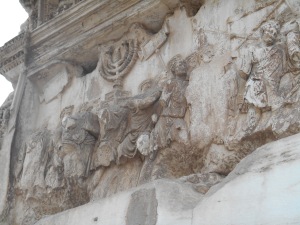Italy is brimming with historical beauty, as we mentioned in the last post. It’s a lot to take in. In Florence, after seeing the Duomo, the cobblestone streets, and a public square shadowed by an enormous archway, we had the following exchange:
Jessica: I can’t handle it!
Andrew: I know; I can’t believe how amazing it all is.
Jessica: No, really, I can’t handle it. I think I’m getting some kind of beauty-induced headache. I’m not sure if I can take any more beautiful sights.
Andrew: Well, listen, don’t turn around, but there might sort-of be a castle behind you.
Our time in Florence was wonderful. While the Duomo is truly breathtaking, perhaps the city’s finest element is its pastoral side. Where Rome has fountains and towering ancient ruins, Florence has quiet streets and gardened villas on rolling green hillsides. If you walk about a half hour south out of the city, you can reach the a high spot called the Piazzale Michelangiolo. Because Florence sits at the bottom of a river valley, you can ascend the steep hillside to get a sweeping view of the entire city. From there, even the Duomo looks small enough to pick up, although it still towers over the maroon sea of Florence’s rooftops. Beyond the the city itself lies the northern hillside of the valley, dotted with homes and vineyards.
Florence has a city marketplace building, the Mercato Centrale, filled with a huge grid of vendor stalls. We’ve been to supermarkets in Italy, but this was something completely different. If you’ve been to Lexington Market in Baltimore, you’ll have some idea what it’s like. There are dozens of sellers with bread, fruit, vegetables, meats, and cheeses. It’s all at really good prices, because every vendor has competition less than ten feet away. In addition to being a cool cultural experience, Italian marketplace shopping has supplied us with excellent lunch ingredients at prices that only instant comparison shopping can provide. At the Piazza Michelangiolo, we brought a picnic of bread, wine, fresh mozzarella, tomatoes, and Roman-style artichokes marinated in sunflower oil and spices, all for much less than even a budget restaurant, and with a gorgeous view to boot.
After Florence, we moved on to the island of Venice. Venice has really quiet streets, since cars aren’t allowed to travel the island. The island is small enough that walking anywhere is generally practical, but for tasks that require rapid transit, the island has an extensive network of canals. Most boats are for private personal use, but we also saw boat taxis, boats carrying construction equipment, a mail-delivery boat, and an ambulance boat.

There’s a reason why cars aren’t allowed on the island: more than few of the streets in the city are about this wide
We took a day trip to Naples to have a taste of the city’s famous pizza. We had lunch at the famed Starita pizzeria, and it lived up to its reputation: Jessica called it the best pizza she’d ever eaten. The bitter char blisters on the crust blend with the sweet tomato and savory cheese for a flavor that can fairly hold the title of “best pizza ever”.
Naples pizza is traditionally eaten with a knife and fork, primarily because it simply not possible to eat it with your hands. The pizza is very soft, and the ingredients would likely slide right off if you tried to eat it by the slice. If knife-and-fork pizza isn’t your style, you can also buy some tasty calzones from street vendors (for a mere one euro each!) that are like fried donuts, filled with meat and cheese.
For our final stop in Italy, we headed back to Rome to visit the Vatican. St. Peter’s Basilica is huge: not only are the ceilings tremendously high, but the hall of the church is full of nested side chapels and prayer rooms. The church is so full of ornate, massive statues that it almost feels a bit like a museum (indeed, some of them have explanatory placards!), but it has an unmistakable holy energy.
So, that’s it for our two weeks in Italy! We’ve arrived safely in the Netherlands, and we’ll have a new post all about that soon.




















